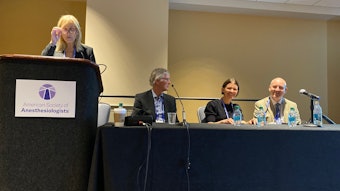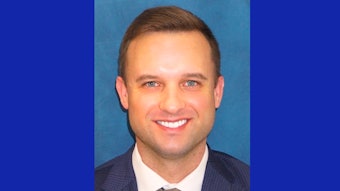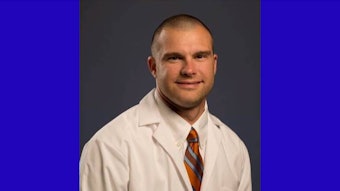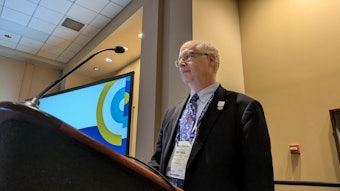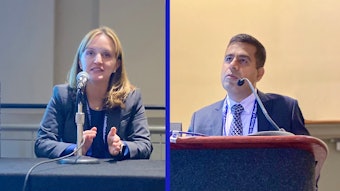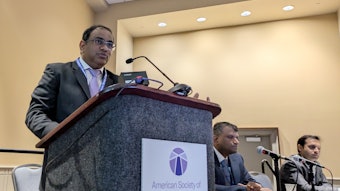Paving pathways for improvement
Could the benefits of implementing ERAS in anesthesia outweigh the trials and tribulations?

Surgery has come a long way in terms of procedural technique and technology advancements. But it wasn’t until 1997 when a group of European surgeons, led by Danish surgeon and Professor Henrik Kehlet, initiated a new approach: Enhanced Recovery After Surgery (ERAS).
The original intent of ERAS was to focus on and improve patients’ recuperation following surgical procedures based on proven standardized processes. Several years later, U.S. health systems began adopting the methodology, and some version of advanced surgical protocols is in place at most institutions today.
During the 2024 session, “Pitfalls & Challenges in ERAS Pathways: Subspecialty Perspective From Cardiac, Obstetric, and Neuroanesthesia,” a panel of experts dove into strategies for implementing ERAS into generalized and specialty surgery departments. Session moderator Anoushka M. Afonso, MD, FASA, will begin the discussion by highlighting the fundamental elements of ERAS and its desired effects.
“The overarching goal of ERAS is to accelerate patient recovery, reduce complications, and enhance the overall experience,” said Dr. Afonso, an anesthesiologist and Director of ERAS programs at Memorial Sloan Kettering Cancer Center in New York City. “While these core principles remain constant, their application varies across surgical specialties.”
What’s in it for me?
It’s true that the patient is the primary beneficiary of ERAS, where they receive standardized care, better recovery, and healthier outcomes. However, health care professionals and health care systems also experience positive results.
A 2021 study in the Journal of Clinical Medicine confirmed that length of stay is reduced by almost 2.5 days on average when following ERAS guidelines. It also found an average savings of $639 per patient. Hospitals may also experience optimization of health care resources and personnel, said Brendan Carvalho, MBBCh, MDCH, FRCA, FASA, Chief of Obstetric Anesthesiology and Maternal Health, Vice Chair of Faculty Development, and Professor, Department of Anesthesiology, Perioperative, and Pain Medicine, at Stanford.
“The two goals of ERAS are to offer evidence-based interventions that have been shown to improve recovery and to obtain measurements to determine that the protocols are being followed and outcomes achieved,” Dr. Carvalho said. “You can’t call it enhanced recovery if you aren’t offering ERAS interventions and capturing core outcome measurements.”
Obstetric anesthesia
Dr. Carvalho has always been invested in improving patient outcomes, but accomplishing this requires backing from a variety of stakeholders. For instance, hospital leaders need to provide information technology support, and clinicians and nurses from different disciplines (e.g., obstetrics, anesthesiology, pediatric, lactation) all need to “buy in” to adopt the ERAS protocols.
“The biggest barrier is that you need the entire village to participate in the protocol or it doesn’t work optimally,” he said. “You’ll never get 100% of the people onboard, but you need enough to standardize the care and ensure every single patient gets the same treatment — and the best treatment.”
Within his expertise in obstetrics, Dr. Carvalho said there’s an added challenge because there are two patients to consider: the mother and the baby. There are also legal requirements for childbirth that dictate insurance-covered length-of-stay, which add to the complexity of fast-track discharge.
“Getting people to become protocol-driven is very challenging,” he said. “Clinicians need to follow evidence-based protocols rather than continue with their individualized and variable practices.”
Cardiac anesthesia
As Professor and Chief of Cardiothoracic Anesthesiology at Stanford University School of Medicine, Louise Sun, MD, SM, FRCPC, FAHA, will discuss her experience in implementing and using ERAS guidelines within the cardiac anesthesiology space. In her practice, this looks like “multimodal analgesia,” in which they prioritize alternative analgesics in place of traditional high-dose opioids, as well as extubating and mobilizing earlier, initiating nutrition sooner, reducing infection, and optimizing glycemic control and wound closures.
“It is a patient-centered pathway aimed to minimize the body’s reaction to surgical stress by improving nutritional status and promoting opioid-sparing analgesia and early postoperative feeding,” she said.
According to Dr. Sun, ERAS has altered the entire philosophy of caring for patients before, during, and after surgery. But for as many benefits that ERAS offers, there are also frustrations and limitations, especially since the guidelines are not universally regulated or required. Dr. Sun recommends identifying advocates or champion users in each area to help drive the initiative at the onset and in the future.
“The more people from diverse specialties and backgrounds, the merrier,” she said. “It’s a great team-building exercise, and the results make it very worthwhile.”
Neuroanesthesia
Although professional organizations have endorsed ERAS pathways for spine surgery, Deepak Sharma, MBBS, MD, DM, said data on ERAS for intracranial operations are limited. There has only been one randomized controlled trial, and research studies have not produced enough systematic analyses to develop a specialized bundle of care.
“You can only have consensus and guidelines when you have enough evidence,” said Dr. Sharma, Professor of Neuroanesthesiology and Perioperative Neurosciences at University of Washington Medicine in Seattle.
The primary desired outcomes, he said, are for patients to be free of neurological deficits and to prevent prolonged hospitalization and readmission. What does this require?
“We need the patient perspective,” said Dr. Sharma. “More collaboration between neuroanesthesiologists, intensivists, interventionalists, and patients is required to find the right targets and define what ‘enhanced recovery’ actually means in the context of neurological conditions.”
Dr. Sharma said he envisions growing interest in scalp blocks and multimodal analgesia for intracranial surgery. Ultimately, the wide range of neurosurgical procedures might dictate distinct ERAS pathways for various neurosurgical conditions.
“The advent of minimally invasive surgical approaches has certainly helped move the field forward, but anesthesiologists still need to identify optimal strategies to control post-craniotomy pain and other factors delaying hospital discharge,” Dr. Sharma said.
Across anesthesiology, the session speakers agree that there is much work clinicians can do to gain evidence, share strategies, and make progress to improve patient care.
